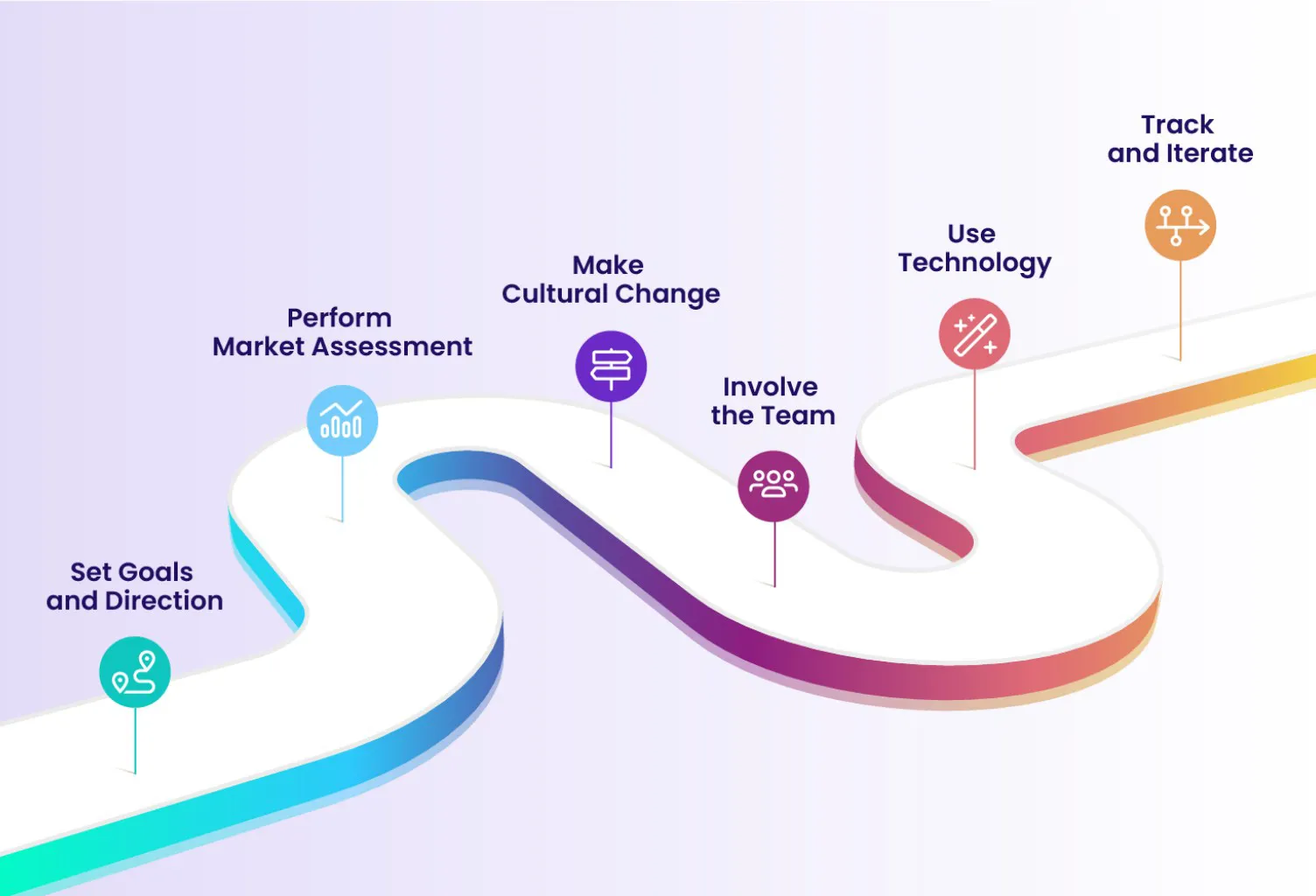
A roadmap for digital transformation

Digital transformation is one of the big buzzwords in business. More than ever, achieving greater digitalization has become a prerogative. But beyond the buzz, what does digital transformation mean and entail?
In a narrower sense, digital transformation is about using digital technology to solve traditional business problems and integrating digital solutions to gain a competitive advantage. In a fuller understanding, it is about a fundamental shift that aligns people, business structure, and processes with technological architecture.
In this latter sense, digital transformation suggests an ongoing process that creates the necessary business agility to keep transforming and adapting rather than having an end goal in sight. However, even without a fixed goal, there’s still a method, which is what a digital transformation roadmap is about.
Ready to embark on your digital digital transformation journey? Here’s how to navigate the seas smoothly!
What is a digital transformation roadmap, and why do you need it?
In a nutshell, a digital transformation roadmap is a comprehensive assessment of your current situation, articulating your destination, the steps you will take to get there, and the milestones you will encounter on the way.
While it may sound simple, having a comprehensive and detailed roadmap is essential for you to achieve success. Deloitte’s finding that “digital strategy drives digital maturity” remains as accurate today as it was in 2015. Incremental change and focusing on individual digital technologies tend to limit the scope of transformation and close the horizon of possibilities.
Instead, a digital transformation strategy’s true power lies in its objectives and the changes it sets in motion to achieve them. This is the main reason for creating a roadmap that will help you to transform your company.
Why pursue transformation in the first place?
As the Deloitte and MIT study showed, digitally mature and maturing businesses pursue digital transformation and use digital technology with the following objectives in mind:
- Improving customer experience and engagement
- Achieving better business decision-making
- Becoming more efficient
- Fostering and improving innovation
- Transforming the business and having a leading edge in one’s field
So how should you approach creating a roadmap, and what are the things you need to keep in mind? Here are a few key questions!

How to build a digital transformation roadmap?
Your digital transformation roadmap is based on the vision and the goals that you want to achieve. The roadmap builds on these by providing precise and detailed responses to the questions below.
Based on your responses, you can then create an implementation plan whose purpose is to lay out the concrete steps you need to take to implement your digital transformation.
Your roadmap must provide you with answers to the following key questions:
1. Why does the business require digital transformation?
The purpose of this question is to help you clarify the main reasons for undertaking this process and what are the benefits of digital transformation for your business. Here it makes sense to conduct an assessment of the internal and external situation of the business, such as:
- Market forces and trends
- Stakeholder and customer expectations, needs, and wants
- The current level of customer experience and potential for improvement
- The business structure’s and digital culture transformation initiatives
2. How can the business be transformed with digital technology?
This question will help you to consider the specific actions you will need to take and the impact of your digital transformation and the changes you will implement. This will include:
- Taking into account the various business scenarios or changes in the business processes that may occur as a result of the transformation
- Considering the impact on customer segments and the new technologies you will adopt
- Concretizing the digital business model you are seeking to build
- Defining a hierarchy of goals and objectives and analyzing the impact they will have on the business models and IT architecture
3. What resources are required for the transformation?
Taking stock of your resources, both those you have available, and those you need to provide further, is an essential part of your digital strategy. Given that resources are limited, you must have a good idea of allocating and using them efficiently to achieve your digital transformation goals.
This may include prioritizing those activities and projects that can support your transformation efforts via more significant ROI, vetting opportunity costs, and freeing up resources that are currently not well spent toward change.
Defining the critical change initiatives and their KPIs is part of this process, as it will help you determine how the transformation is going.
4. What is the timeline for successfully transforming the business?
Finally, it would help if you considered making a digital transformation framework answering the questions:
Are you talking months or years? Will you be sequencing the change in stages, or will you push everything at once? Have you planned all the changes, or will you make adjustments as you go, trying out different possibilities? Do certain areas have greater priority, and if so - how and when will be focusing on them?
Defining the timeframe for your business’s digital transformation process helps settings the groundwork for change. It’s as much about creating reference points as it is about moving the project from ideation to implementation.
3 Tips for your digital transformation roadmap success
Are you ready to set out on your transformation journey? Here are a few tips to help you on the way to a successful digital transformation:
1. Make it a company effort
Getting buy-in from senior management and business leaders is one of the keys to the success of a transformation roadmap. For this purpose, you can appoint change leaders who will communicate the meaning, goals, and value of the transformation within the company, employees, and customers.
The more you can involve the whole company in the digital transformation effort, the greater the likelihood of success.
2. Maintain a fast pace and share successes to keep the spirits up
A faster initial pace of transformation has been shown to result in the greatest digital transformation success (McKinsey). Quick wins early in the process enable companies to free up resources and capacity and reinvest these back. Keeping up this rhythm and communicating successes internally helps maintain the rhythm and achieve goals sooner.
While each instance is unique, faster performance and implementation seem to work better for most companies.
3. Manage change with software
Using software to help you with the transformation process’s different aspects can significantly ease the task. Whether it’s a digital adoption platform (DAP) or software to gather feedback or communicate news - consider implementing digital tools to help you manage the change efficiently.
Ready to start your digital transformation initiatives?
Resolute Software has years of experience supporting companies undertaking their digital transformation journey. Our expertise in the field has made us a trusted partner in the process, resulting in success stories all over the globe.
Are you ready to start your new digital journey? Get in touch to learn more about how Resolute Software can contribute to your organization’s digital transformation efforts.
FAQs
To create a digital transformation roadmap, you must clarify your vision and goals. You must assess your company’s readiness to undergo a transformation and the impact this will have on it internally and externally. Next, you must plan how to execute the transformation and what resources are required. Finally, you must determine the timeframe of the change.
A digital roadmap is the path and concrete steps that you plan on taking when transforming a more encompassing digital business model. The roadmap specifies the extent to which your company will transform and how you will go about achieving this transformation.
The key elements that must be present in a roadmap include the purpose and goals of the transformation, the steps and stages of the process, and the key digital strategies and activities that will drive the transformation. It must also specify the milestones you plan on hitting, the available resources, and how you will allocate them.





